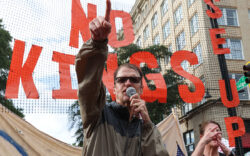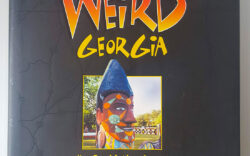Test pilot Chuck Yeager rode a rocketship into history 75 years ago, when he became the first human to fly faster than the speed of sound on Oct. 14, 1947. Huddled in the cramped cockpit of a tiny but powerful aircraft dubbed the X-1, Yeager fired four rocket engines that blasted the plane to a supersonic speed of more than 700 miles per hour, sending the world’s first sonic boom into the clear California skies above what is now Edwards Air Force Base.
Today, Yeager’s X-1 rocketplane hangs in a place of honor in the Smithsonian Air & Space Museum in Washington. With a bright orange fuselage shaped like a bullet, the X-1 still exudes speed and power 75 years after Chuck Yeager first flew it on risky run past a “sound barrier” that turned out to be no barrier for Yeager and the other pilots who have followed him into the supersonic realm over the decades. Yeager named his little aircraft “Glamorous Glennis” after his wife, and her name is painted in red letters on the nose of the aircraft. The X-1 helped set America on the pathway to space, and it is fitting that it is now displayed in the same vast museum as the Wright Brothers’ first airplane from 1903, the X-15 aerospace plane that broke speed and altitude records in the 1960s, John Glenn’s tiny Mercury spacecraft from 1962 and the Apollo 11 capsule that took men to the moon and back in 1969.
“The secret of my success is that I always managed to live to fly another day,” said Yeager, and he had put his life on the line as an aviator long before his history-making flight aboard the X-1 in 1947. Born in 1923, Chuck Yeager lived a long and eventful life until his death at the age of 97 in 2020.
In World War II Yeager began his military service as an airplane mechanic, but he switched to the job of pilot when he said that he “saw pilots had beautiful girls on their arms, didn’t have dirty hands, so I applied” for flight training. Yeager excelled at the deadly game of war in the air, becoming a scourge of the Nazi Luftwaffe as the pilot of a sleek and speedy P-51 Mustang fighter that he also named for his wife. Shot down over France in 1944, Yeager was aided by members of the French Resistance who helped him make it back to his base in England.
Just a few months after being shot down, Yeager was back in the cockpit. On Oct. 12, 1944–three years before his postwar supersonic flight–Yeager became an “ace in a day” when he shot down five German planes during one mission. In all, nearly a dozen Nazi planes fell to Yeager’s guns during the war, including a German jet fighter that he shot down as it was landing. “The first time I ever saw a jet, I shot it down,” Yeager recalled.
After the war, Yeager honed his skills as a test pilot at Edwards Air Force Base, that citadel of The Right Stuff saluted in author Tom Wolfe’s 1979 book and in the 1983 film of that title. Without a college degree, Yeager was ineligible to become a spacefaring astronaut during the Mercury, Gemini and Apollo programs, and he never flew the X-15 rocketplanes that took pilots on speed runs of more than six times the speed of sound and to altitudes of nearly 70 miles into suborbital space. Still, Yeager was a formidable warrior and a pioneering test pilot who rose through the ranks from airplane mechanic to general. “All that I am, I owe to the air force,” he said.
In 1953, the 50th anniversary of the first flights by the Wright Brothers in 1903, Yeager achieved another aviation milestone when he rocketed to what was then a record speed of more than twice the speed of sound. The aviator told the story of all his aerospace exploits in his best-selling 1985 autobiography, Yeager.
By the end of this decade, airlines hope to have supersonic passenger planes that are less noisy, more affordable and more fuel-efficient than the ill-fated Concorde supersonic airliner that last flew in 2003. When such futuristic flights take wing, they will fly because of an old aviator named Chuck Yeager, who once said, “I haven’t yet done everything, but by the time I’m finished I won’t have missed much.”
Like what you just read? Support Flagpole by making a donation today. Every dollar you give helps fund our ongoing mission to provide Athens with quality, independent journalism.









